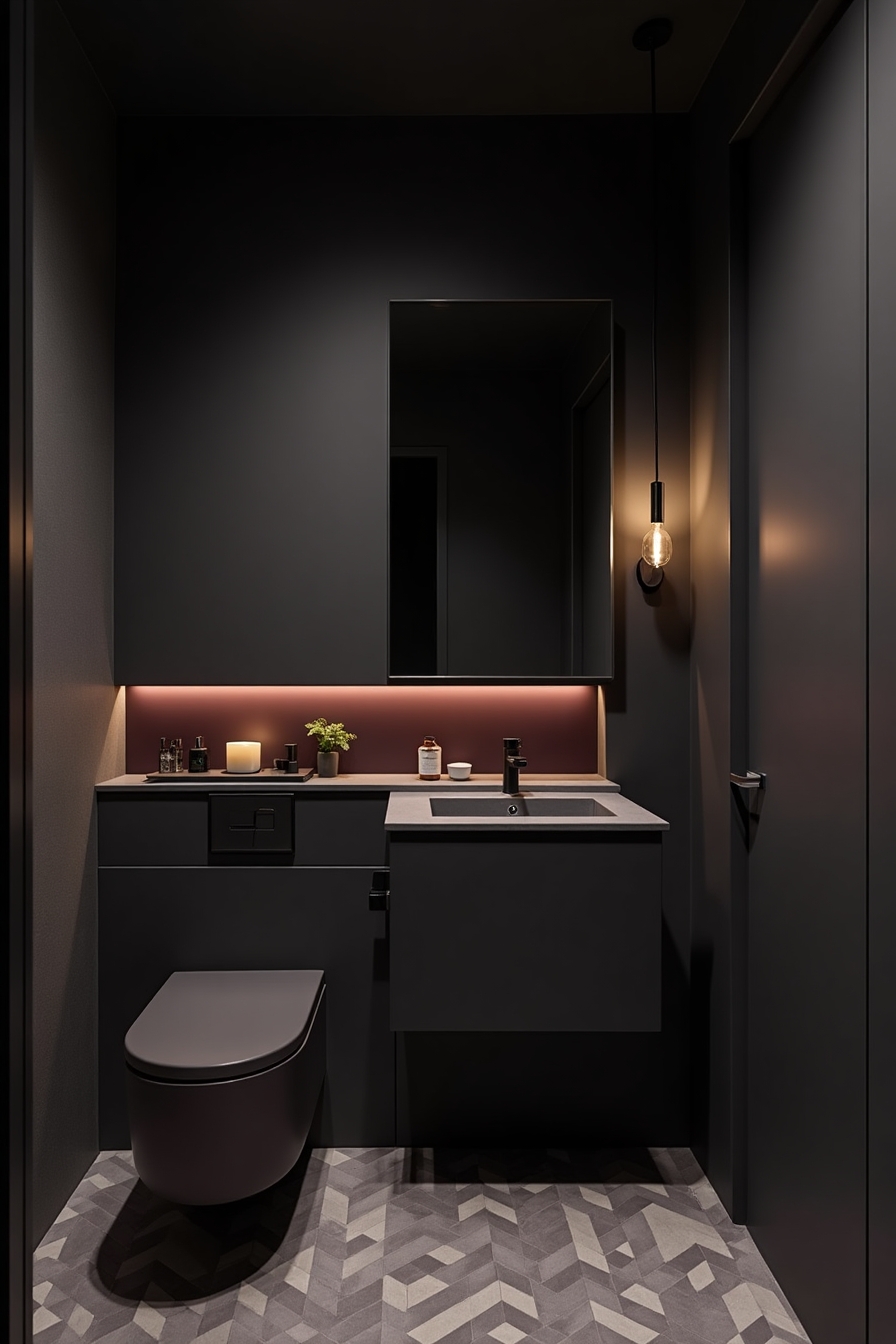Small dark bathrooms often present one of the biggest design challenges in any home.
Most people try to fight the darkness with harsh lighting and white paint, completely missing the opportunity to create something truly special.
These aren’t typical bathroom ideas—they’re game-changers that will completely revolutionize how you see your small dark bathroom’s potential.
✨Click to Get My 101 FREE Designer Room Ideas
Dramatic Lighting Layers That Create Depth and Illusion
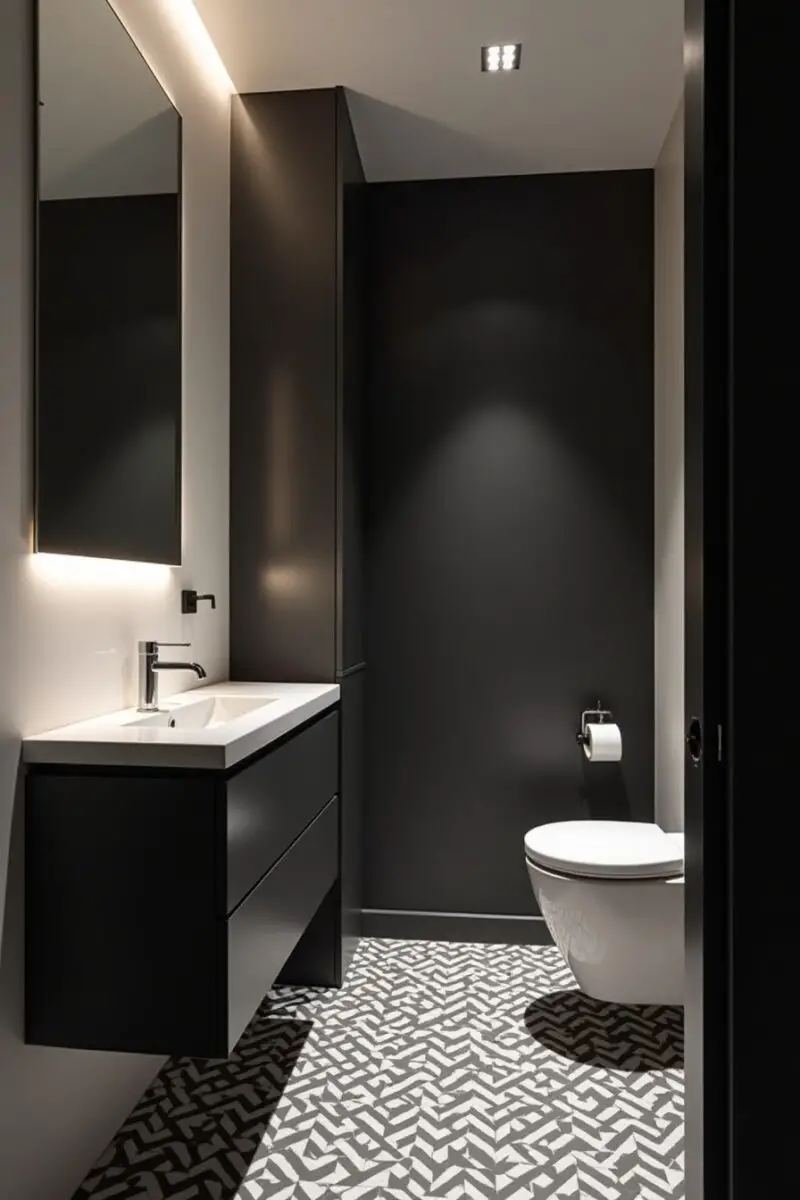
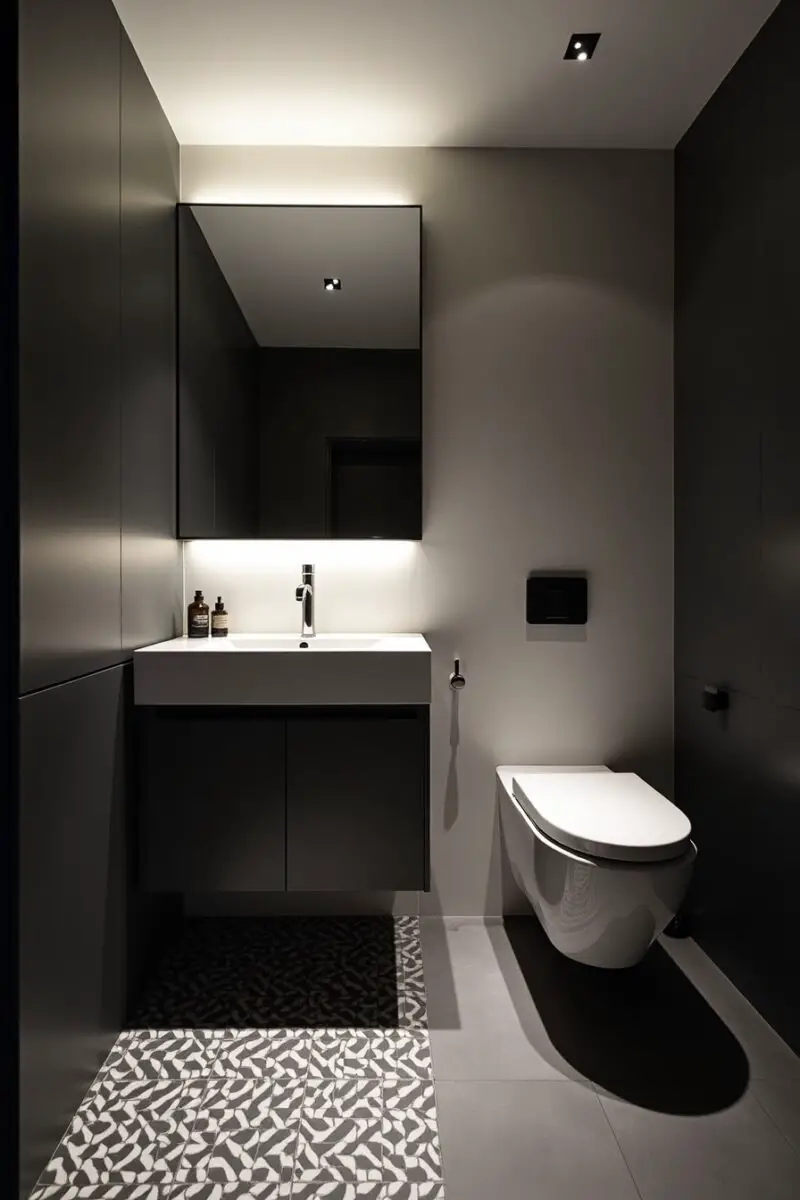
Forget what you’ve heard about bright white lights being the only option for dark spaces.
Strategic lighting is your secret weapon in a small dark bathroom, creating depth that makes the room feel infinitely larger.
Start with a statement ceiling fixture that draws the eye upward—a small crystal chandelier or modern geometric pendant can create unexpected luxury in the smallest space.
Wall sconces positioned at eye level on either side of your mirror eliminate unflattering shadows while adding a hotel-like sophistication.
Add unexpected lighting under floating vanities or shelves to create the illusion of floating elements, making the floor space appear larger and more continuous.
LED strip lighting hidden behind mirrors or inside niches creates dramatic halos that add depth without harsh brightness.
Consider color-changing smart bulbs that allow you to shift the mood from energizing morning light to relaxing evening ambiance with a simple voice command or tap on your phone.
Candlelight-mimicking fixtures with flickering LED technology create movement in the space that static lighting can’t achieve.
Remember that in dark bathrooms, it’s about controlling where light falls, not flooding the room with brightness.
Small, targeted light sources create more visual interest than a single overhead fixture ever could.
Reflective Dark Tiles That Multiply Light and Space
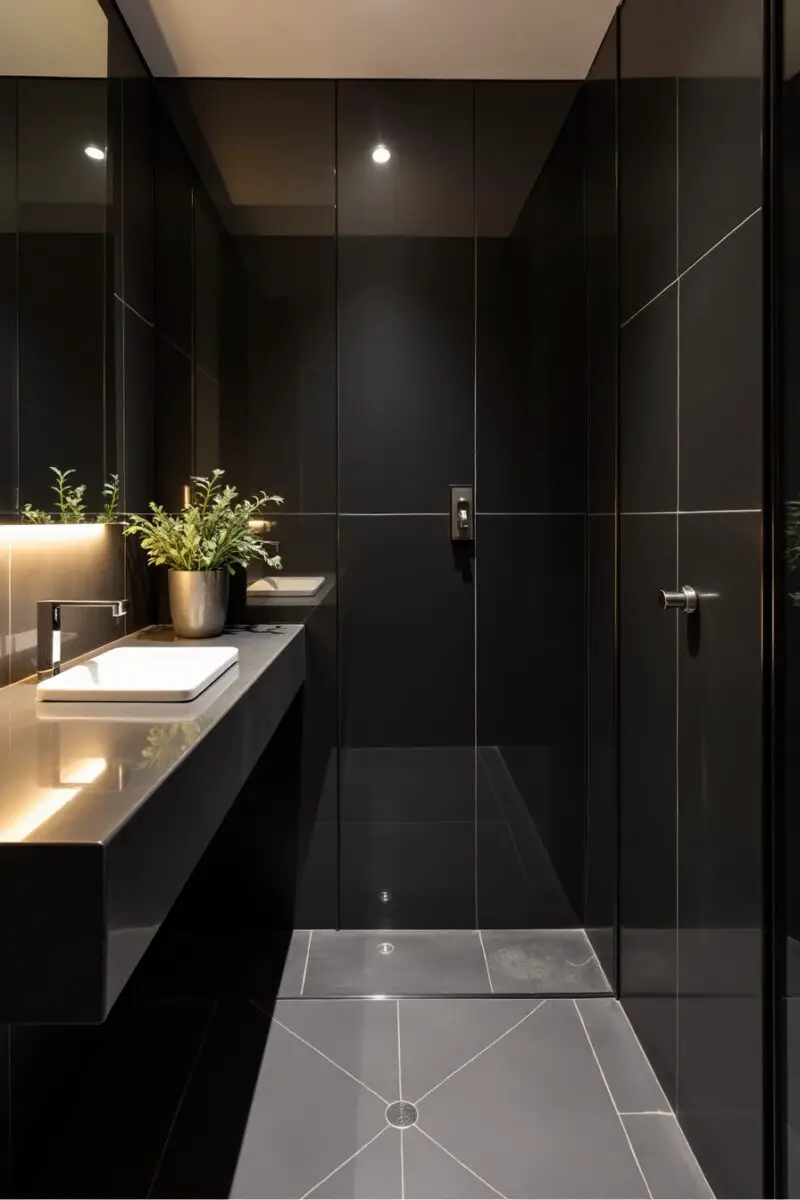
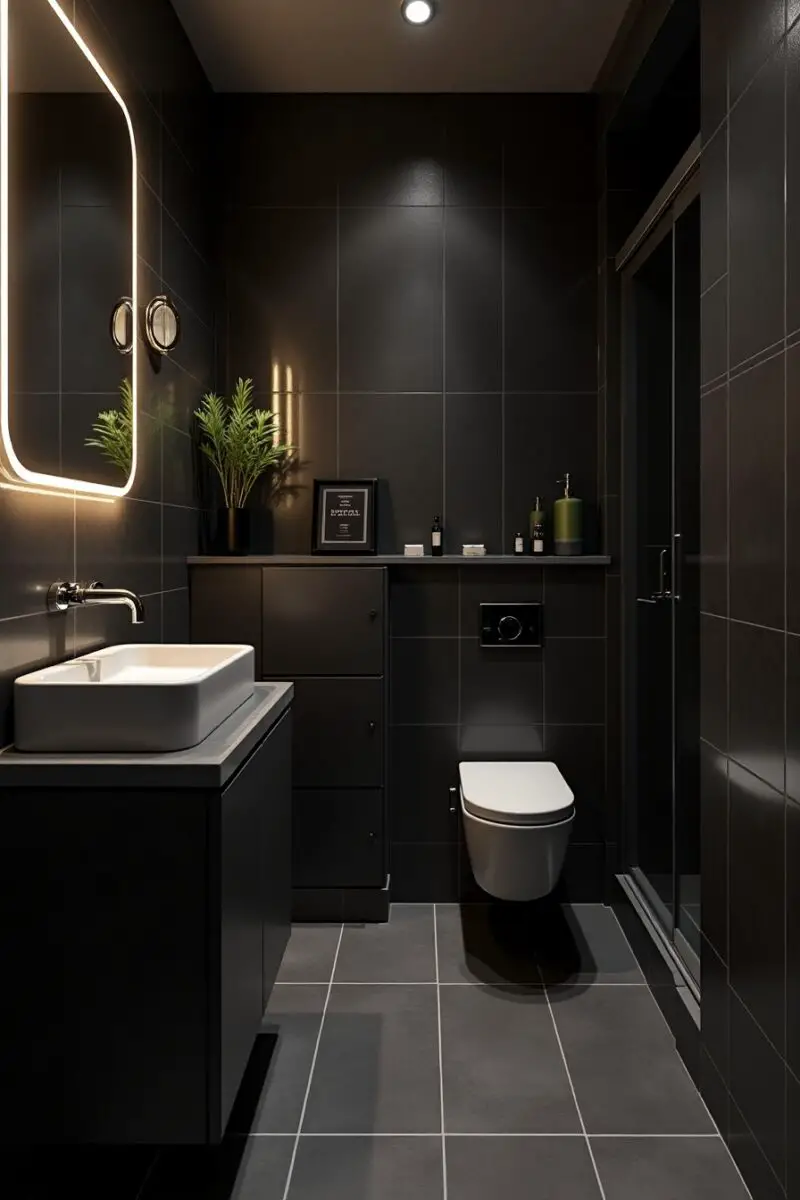
Dark bathroom tile doesn’t have to make your space feel like a cave—when chosen correctly, it can actually amplify what little light you have.
Opt for glossy black subway tiles that reflect light rather than absorb it, creating a sophisticated backdrop that bounces illumination throughout the room.
Navy blue penny tiles with a glazed finish offer depth while providing subtle light-reflecting properties that flat matte tiles simply can’t deliver.
Consider large-format charcoal tiles with a slight metallic sheen for walls—fewer grout lines create a seamless look that visually expands the space.
For maximum impact, carry the same dark tile from floor to ceiling in the shower area, creating an unbroken line that tricks the eye into seeing a larger space.
Experiment with laying traditional black tiles in unexpected patterns like herringbone or basketweave to add movement and interest to a small space.
Don’t be afraid to mix tile sizes and shapes while staying in the same color family—a combination of hexagons and rectangles in varying shades of deep gray creates texture without chaos.
Beveled dark tiles catch light at different angles, creating subtle dimension that flat tiles can’t achieve.
The contrast between dark tiles and light grout can create a graphic element that adds personality without overwhelming the space.
Remember that small samples don’t always convey how reflective a tile will be—view them under your actual bathroom lighting conditions before committing.
Metallic Accents That Pop Against Dark Backgrounds

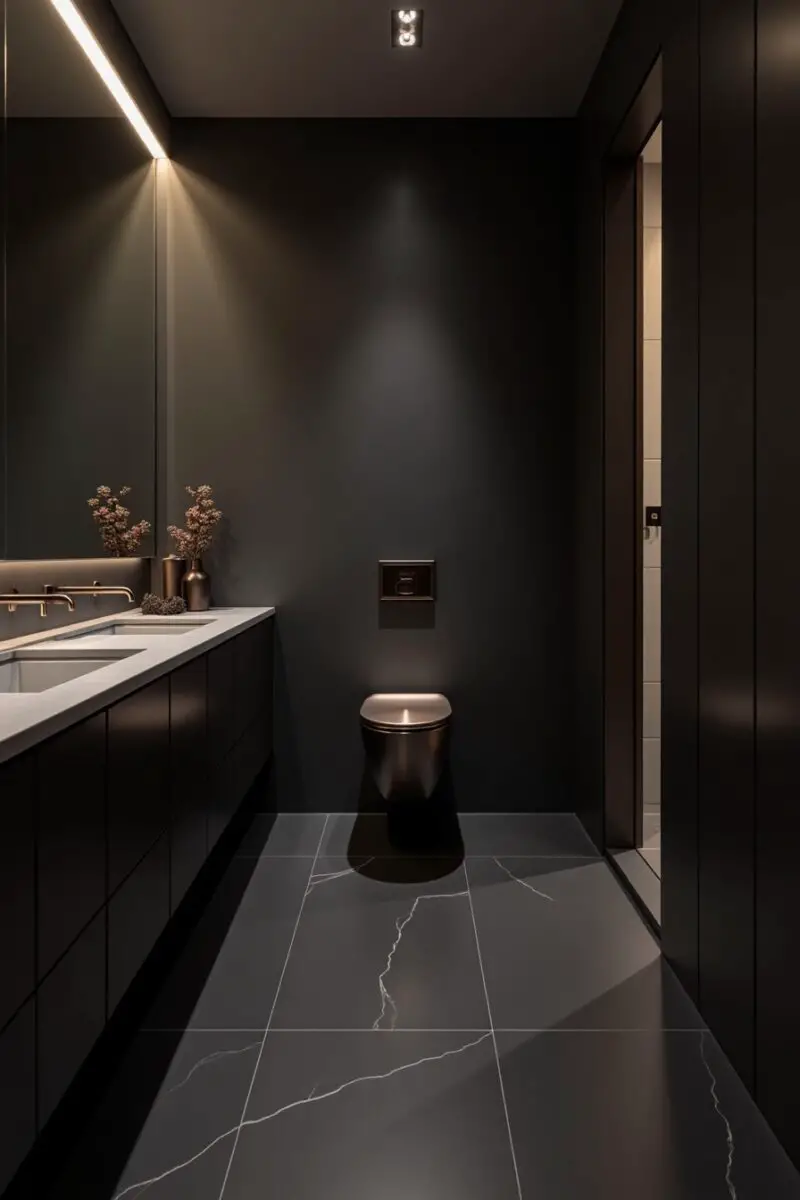
In a small dark bathroom, metallics aren’t just decorative—they’re functional light-enhancers that become even more impactful against deep-colored backgrounds.
Unlacquered brass fixtures develop a living patina over time, adding warmth and character that feels especially luxurious against charcoal or navy walls.
Consider mixing metallic finishes—perhaps matte black faucets with brass mirror frames—for a collected-over-time look that exudes confidence.
Copper accessories like soap dishes or toothbrush holders develop a beautiful verdigris in bathroom environments, creating evolving points of interest.
Install metallic penny tiles or a subtle geometric pattern on one wall for a glamorous focal point that reflects both artificial and natural light.
Antiqued mirror panels with brass trim can replace traditional tile in shower niches, adding depth while functionally brightening the space.
Hardware is your bathroom’s jewelry—oversized brass cabinet pulls transform basic vanities into custom-looking pieces.
Consider metal-framed shower doors with minimal profiles that create architectural interest without visual weight.
Metal light fixtures with perforated designs cast interesting shadow patterns that add another dimension to your walls.
Remember that in small dark spaces, a little metallic goes a long way—focus on a few quality pieces rather than filling every surface with shine.
Space-Defying Storage Solutions For Tiny Dark Bathrooms
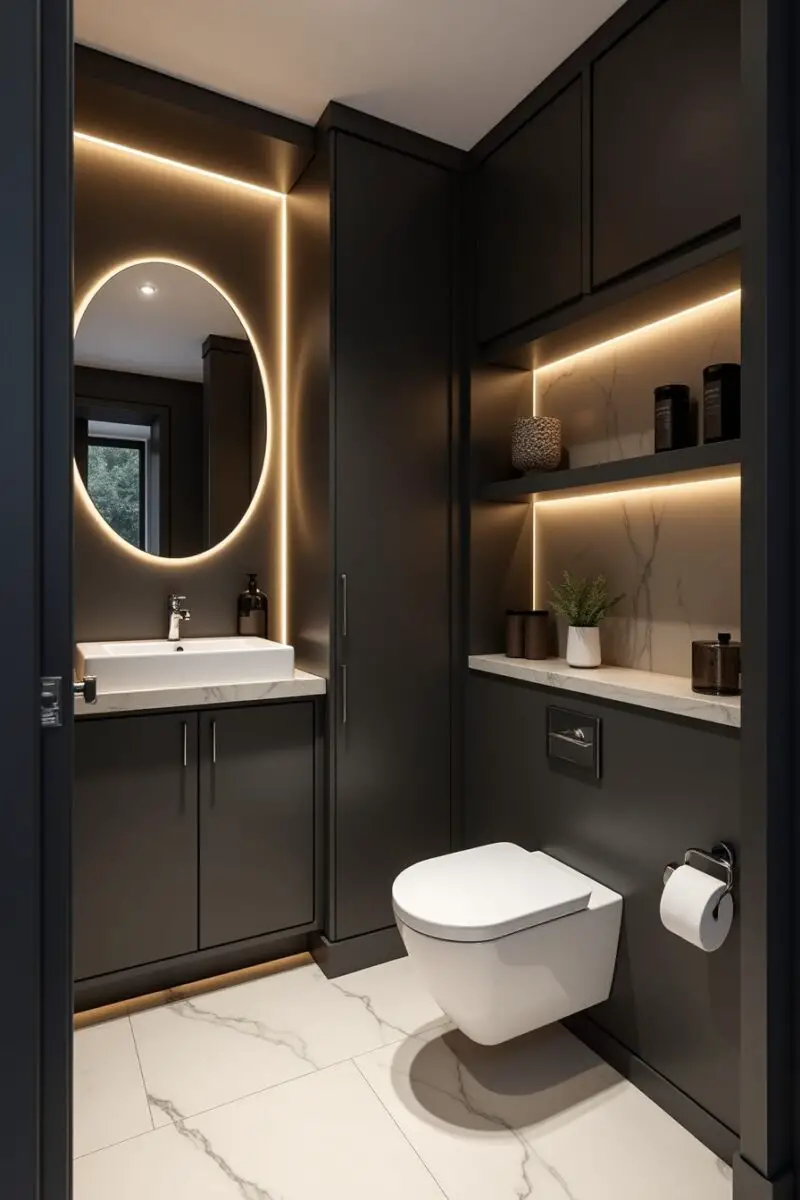
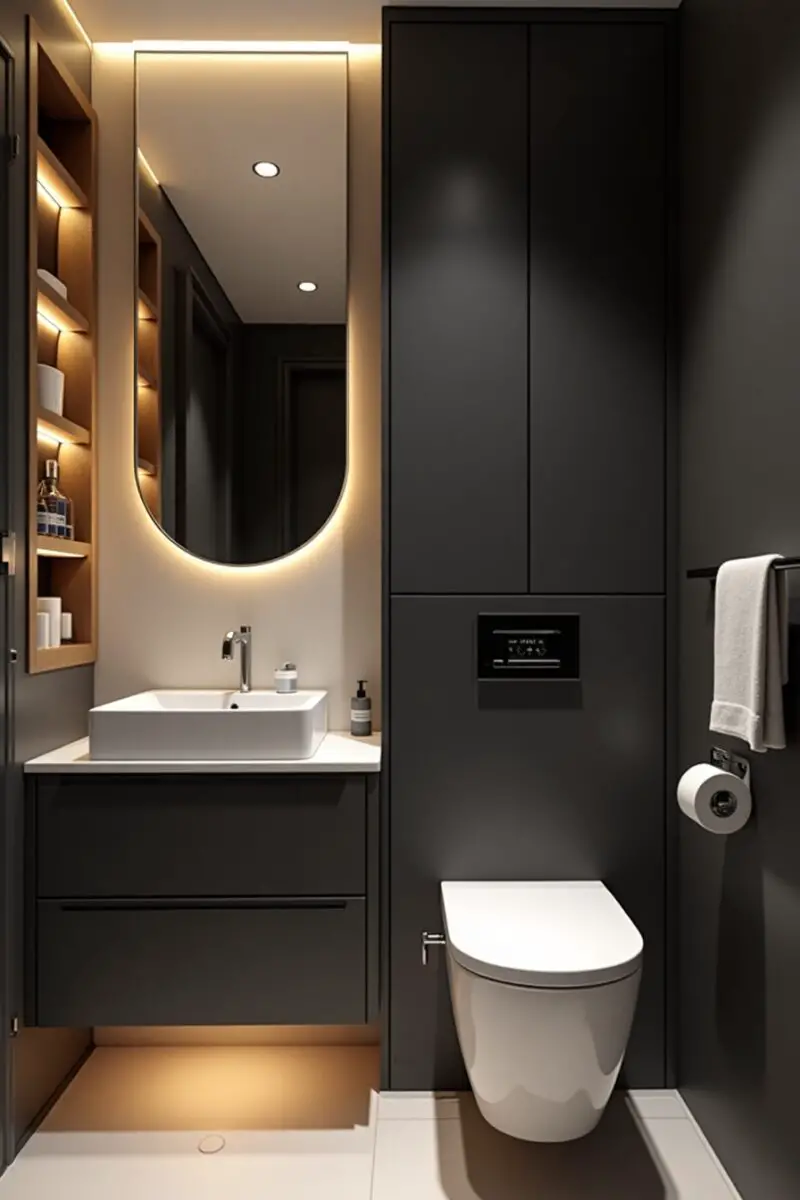
Traditional bulky bathroom storage can make a small dark space feel even more cramped—but innovative solutions can actually create the illusion of more room.
Floating vanities with hidden drawers keep the floor visible, creating a continuous visual plane that makes the room feel significantly larger.
Consider replacing traditional medicine cabinets with slender recessed niches built between wall studs—they provide storage without protruding into precious space.
Install floor-to-ceiling built-in cabinetry in a single dark color that blends into your walls, creating seamless storage that disappears visually.
Utilize the often-forgotten area above the toilet with floating shelves in the same finish as your walls for a storage solution that virtually disappears.
Magnetic strips hidden underneath cabinets can hold metal grooming tools, keeping countertops clear while maintaining easy access.
Consider a custom shower niche that spans the entire wall rather than a small standard-sized opening—this creates significant storage while looking intentionally designed.
Replace traditional towel bars with sleek hooks that require less wall space while actually holding towels more efficiently.
Look for corners and awkward spaces to add custom shelving that turns previously wasted areas into functional storage.
Remember that dark colors recede visually—storage solutions painted the same deep color as your walls will appear to take up less visual space than contrasting ones.
✨Click to Get My 101 FREE Designer Room Ideas
Statement Mirrors That Redefine Your Space
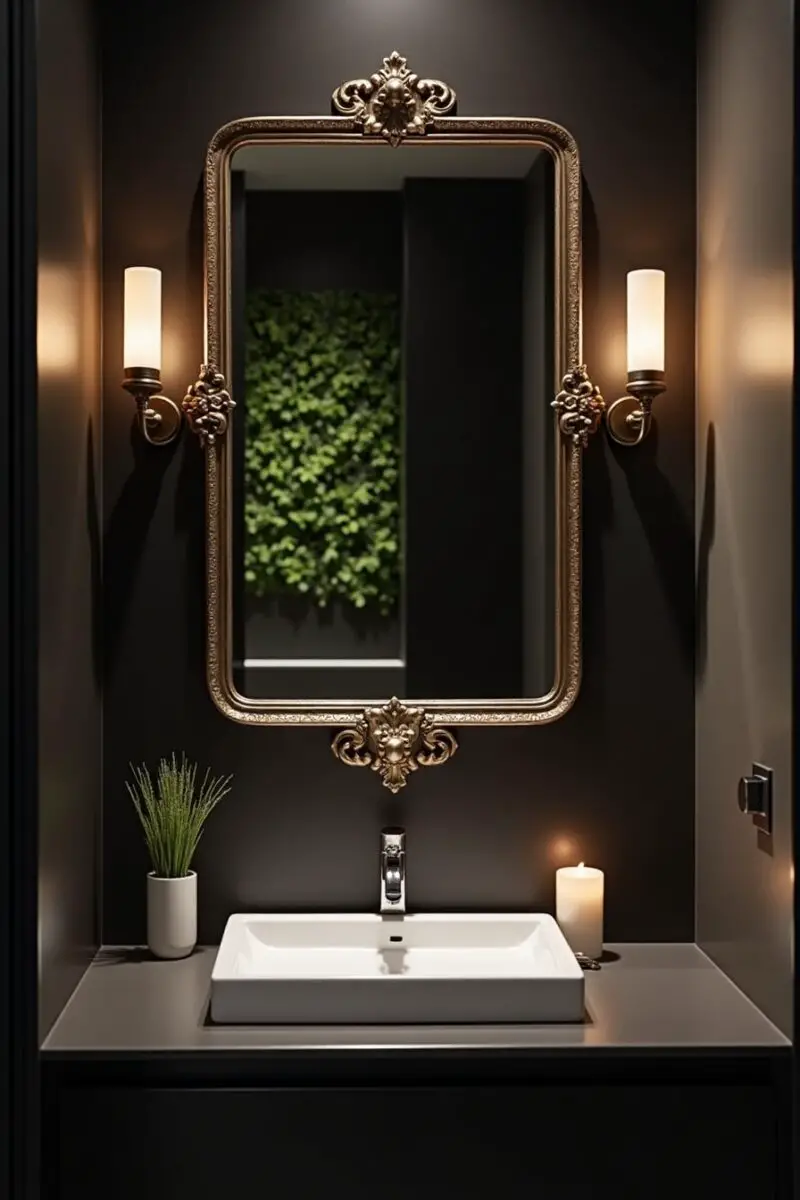

In small dark bathrooms, mirrors aren’t just practical necessities—they’re powerful tools for manipulating perception and multiplying light.
Consider an oversized mirror that spans an entire wall, creating the illusion of doubled space while reflecting every available light source.
Backlit mirrors provide both practical task lighting and a floating effect that adds depth to flat walls.
Experiment with unconventional shapes—an arch-topped mirror adds architectural interest and height to basic rectangular spaces.
Consider a collection of smaller decorative mirrors arranged gallery-style instead of one large mirror for an artistic approach that still serves a functional purpose.
Antique mirrors with subtle spotting and patina add age and character to new bathrooms while softening reflections for a more flattering look.
Install mirrors strategically to reflect your bathroom’s best features—perhaps positioning one to capture and multiply your beautiful light fixture or artwork.
Consider mirrored cabinet fronts that provide storage while visually disappearing into the space.
Pivoting floor-to-ceiling mirrors can make even the smallest bathroom feel like a luxurious dressing room.
Remember that in dark bathrooms, mirrors with minimal frames or beveled edges maximize reflective surface area for optimal light-enhancing effect.
Bold Fixtures That Become Artistic Focal Points
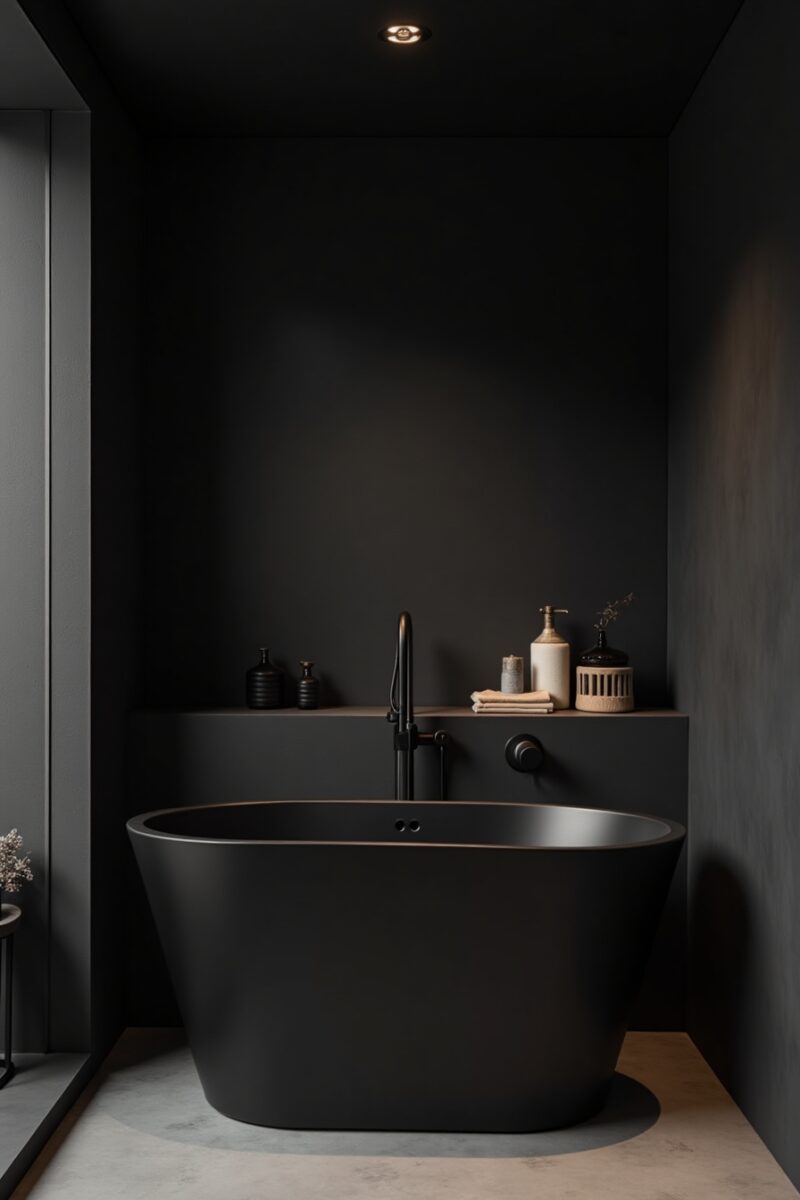
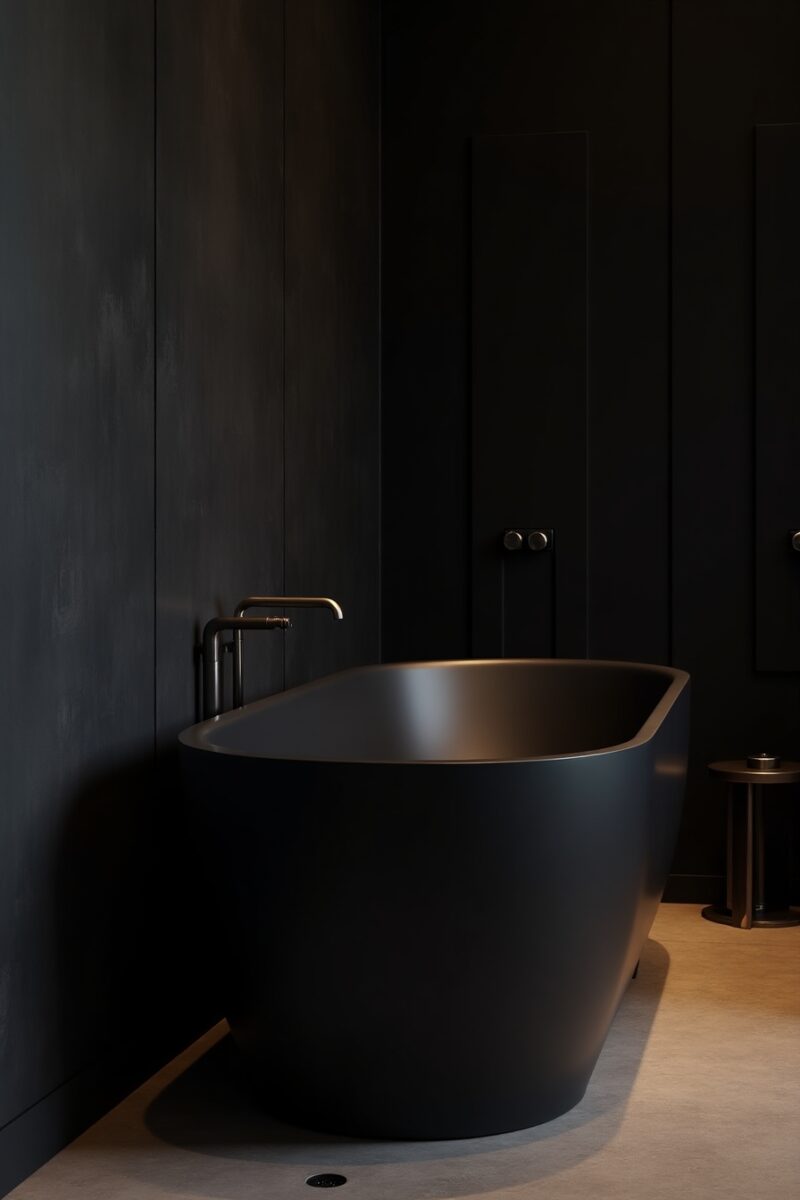
When working with a small dark bathroom, statement fixtures can transform utilitarian necessities into sculptural art pieces that elevate the entire space.
Consider a matte black freestanding tub with a modern silhouette that becomes a dramatic centerpiece against dark walls.
Wall-mounted faucets with architectural spouts free up valuable counter space while creating a custom, high-end look.
Look beyond chrome and nickel to unexpected finishes like oil-rubbed bronze or even concrete for fixtures that feel uniquely curated.
Vessel sinks in dramatic materials like hammered copper or blackened granite add textural interest at eye level.
Consider a rainfall shower head in an oversized scale that creates a luxurious experience while drawing the eye upward to enhance ceiling height.
Replace standard toilet handles with decorative levers that add an unexpected touch of personality to an often-overlooked fixture.
Integrated LED lighting in shower niches or toilet seats offers both practical function and unexpected ambiance.
Look for opportunities to customize standard fixtures—perhaps a special order colored drain cover that matches your hardware instead of the standard chrome.
Remember that in small spaces, a single extraordinary fixture makes more impact than multiple competing focal points.
Texture Play That Adds Dimension Without Cluttering
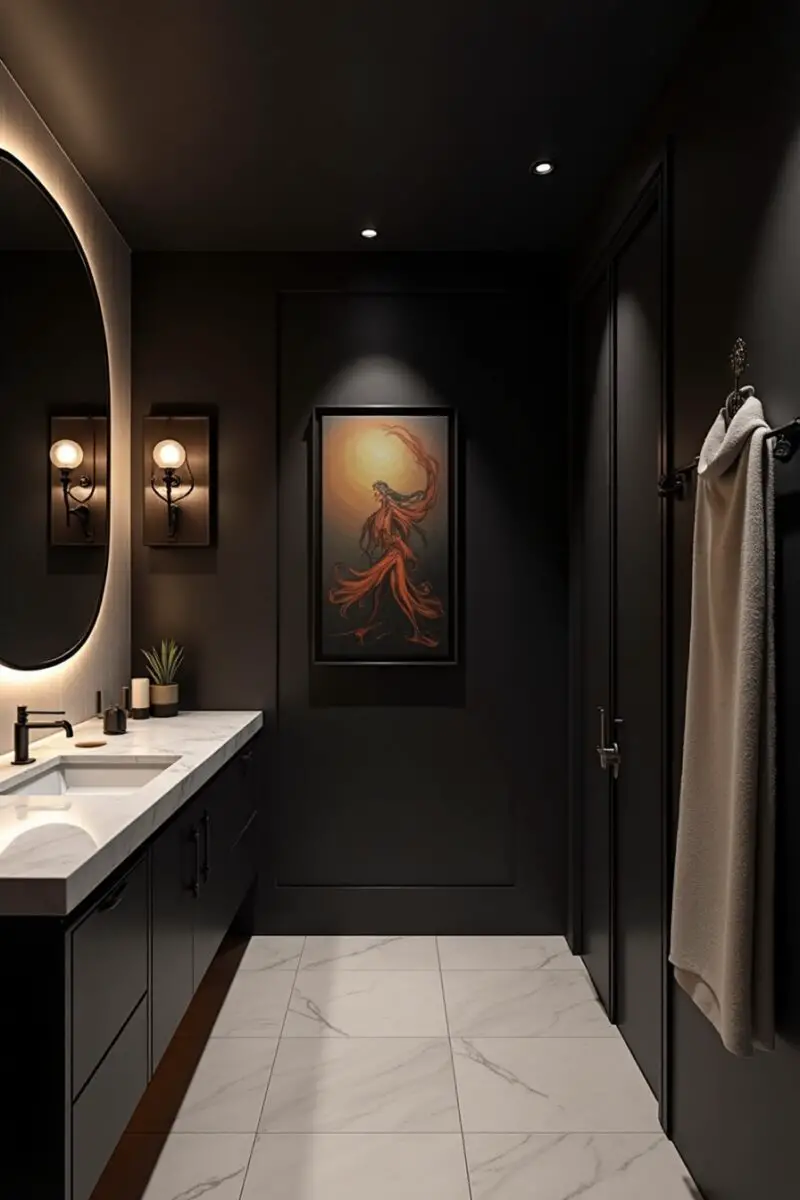
In small dark bathrooms, texture becomes even more important than color, creating visual interest and depth without requiring additional space.
Consider fluted glass shower doors that provide privacy while allowing light to filter through in a more interesting way than standard frosted glass.
Incorporate ribbed wood vanities or wall panels that add tactile warmth to cool tiled surfaces.
Experiment with three-dimensional tiles in monochromatic dark shades—the shadows created by their patterns add complexity without color contrast.
Introduce natural stone with dramatic veining that creates organic movement across surfaces.
Consider micro-cement or tadelakt plaster finishes that create subtle texture while remaining completely waterproof.
Add woven elements like rattan mirror frames or baskets that bring organic texture to sleek contemporary spaces.
Look for opportunities to mix matte and glossy surfaces in the same color family—perhaps matte floor tiles with glossy shower walls.
Incorporate textiles with subtle patterns or interesting weaves—Turkish towels with hand-knotted fringes add artisanal character.
Remember that in dark bathrooms, texture is best appreciated with strategic lighting that creates shadows and highlights the dimensional qualities.
Unexpected Color Accents That Energize Dark Palettes


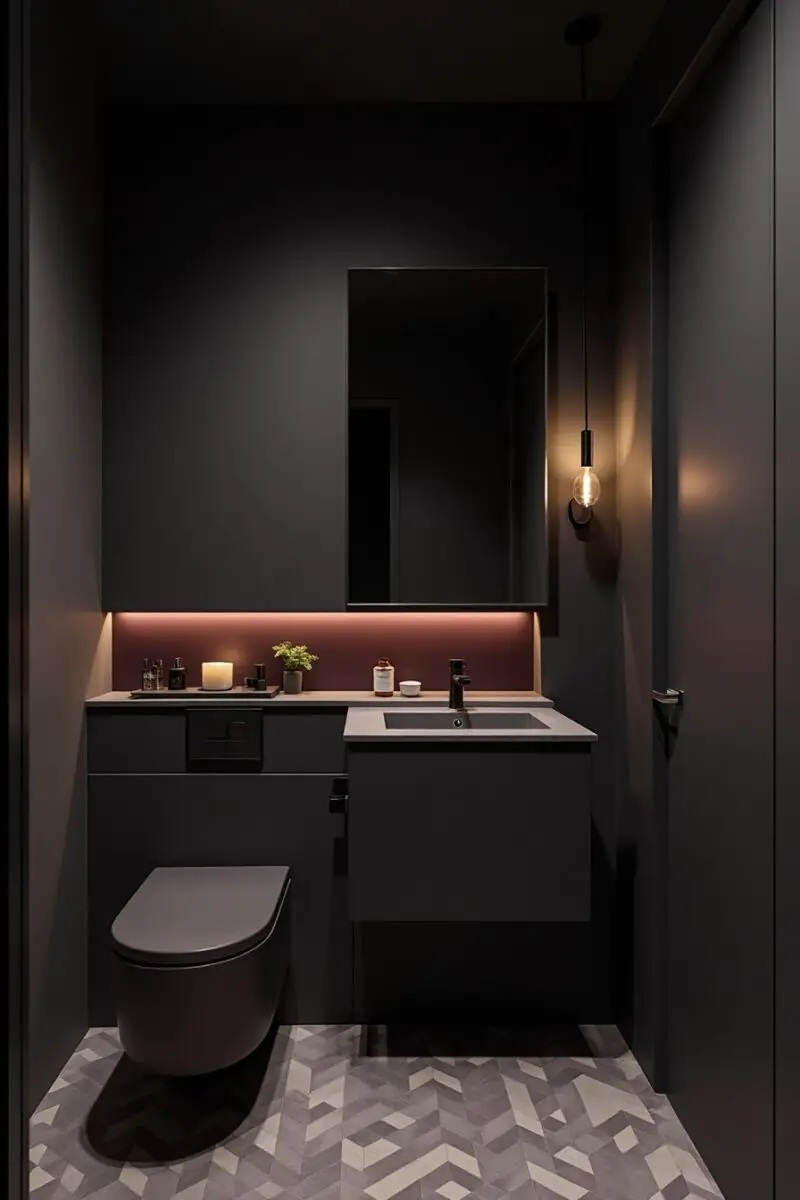
Dark bathrooms don’t have to be limited to blacks, grays, and navy blues—strategic color accents can bring energy while maintaining the sophisticated dark atmosphere.
Consider emerald green accessories that pop against charcoal backgrounds while still feeling cohesive with a dark palette.
Introduce deep burgundy or aubergine towels that add richness rather than brightness to your color scheme.
Look for opportunities to incorporate small amounts of burnished gold or copper that warm up cool dark tones.
Consider botanical wallpaper with a dark background on a single wall—the pattern adds interest while maintaining the room’s intimate feel.
Unexpected color can appear in grout choices—perhaps a deep burgundy grout between black tiles for a subtle but impactful detail.
Incorporate colored glass accessories that catch light in a more interesting way than transparent options.
Consider a single vibrant art piece that becomes a focal point against dark walls.
Even white elements can function as “color” in a dark bathroom—crisp white towels create dramatic contrast against deep-colored surroundings.
Remember that in small dark spaces, a little color goes a very long way—focus on quality and placement rather than quantity.
✨Click to Get My 101 FREE Designer Room Ideas
Optical Illusions That Trick The Eye Into Seeing More Space
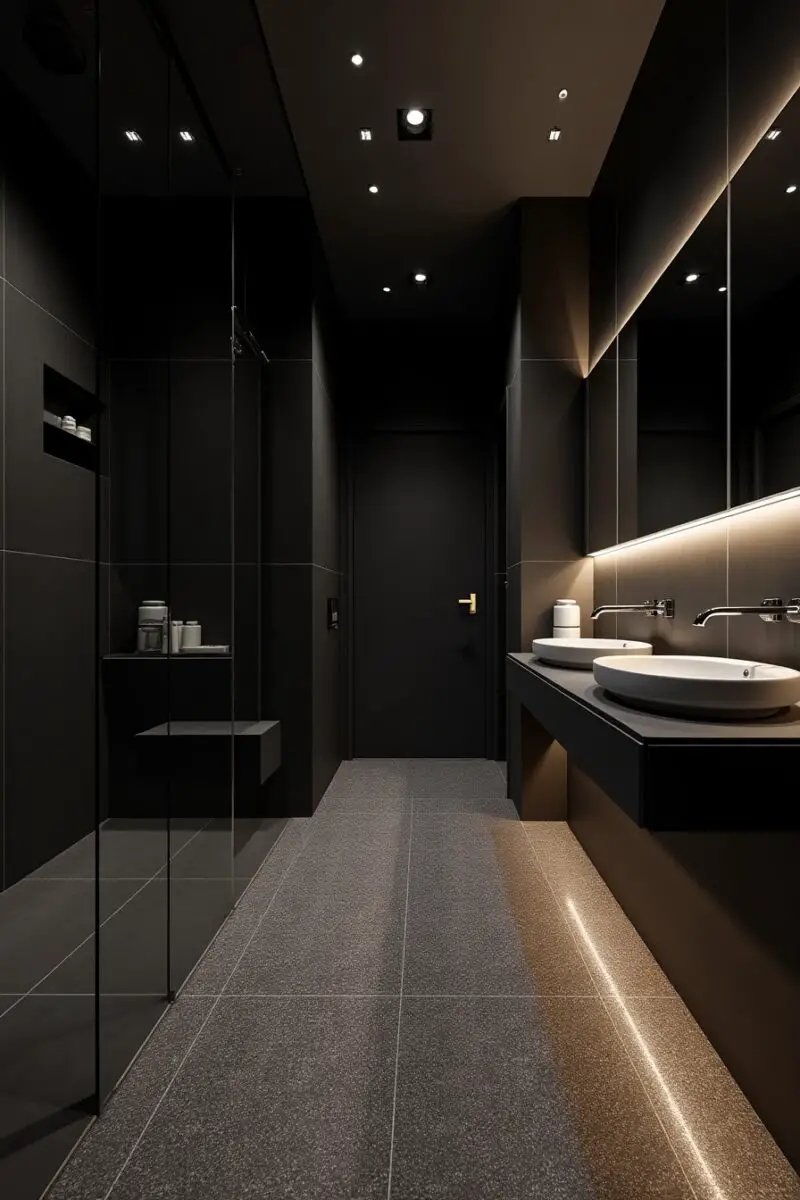
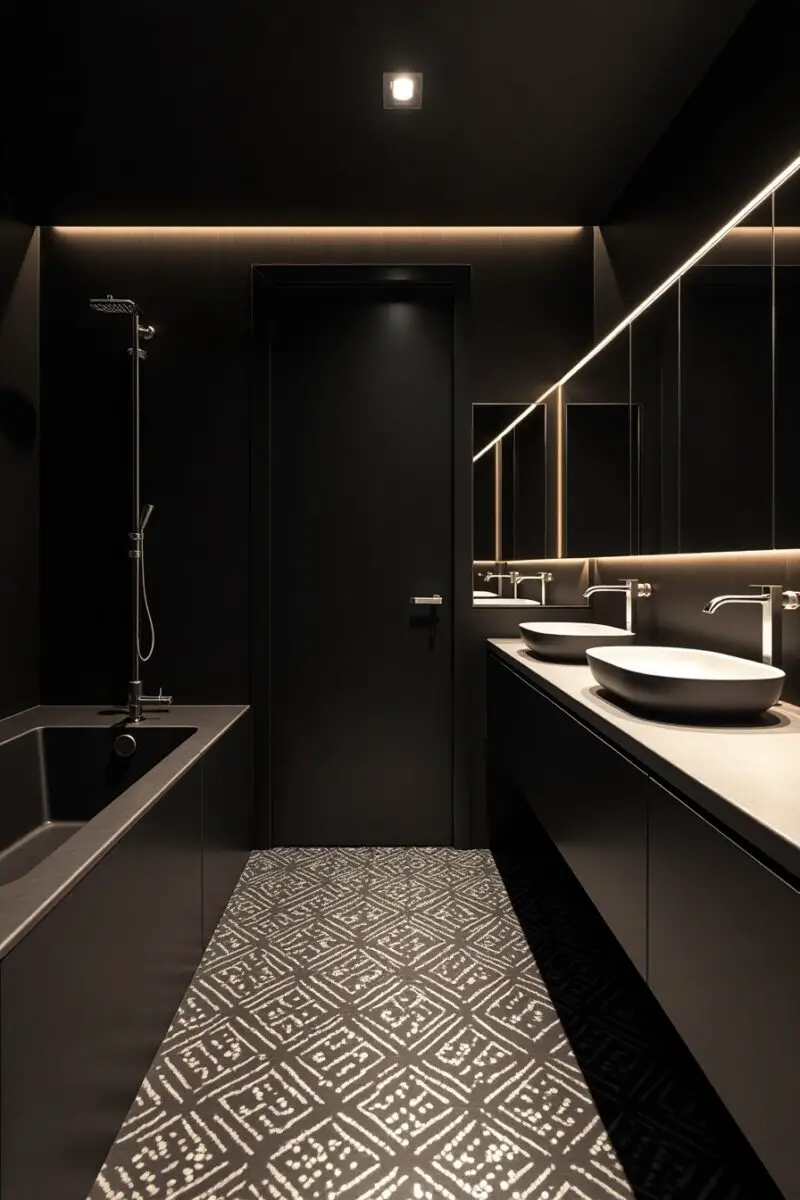
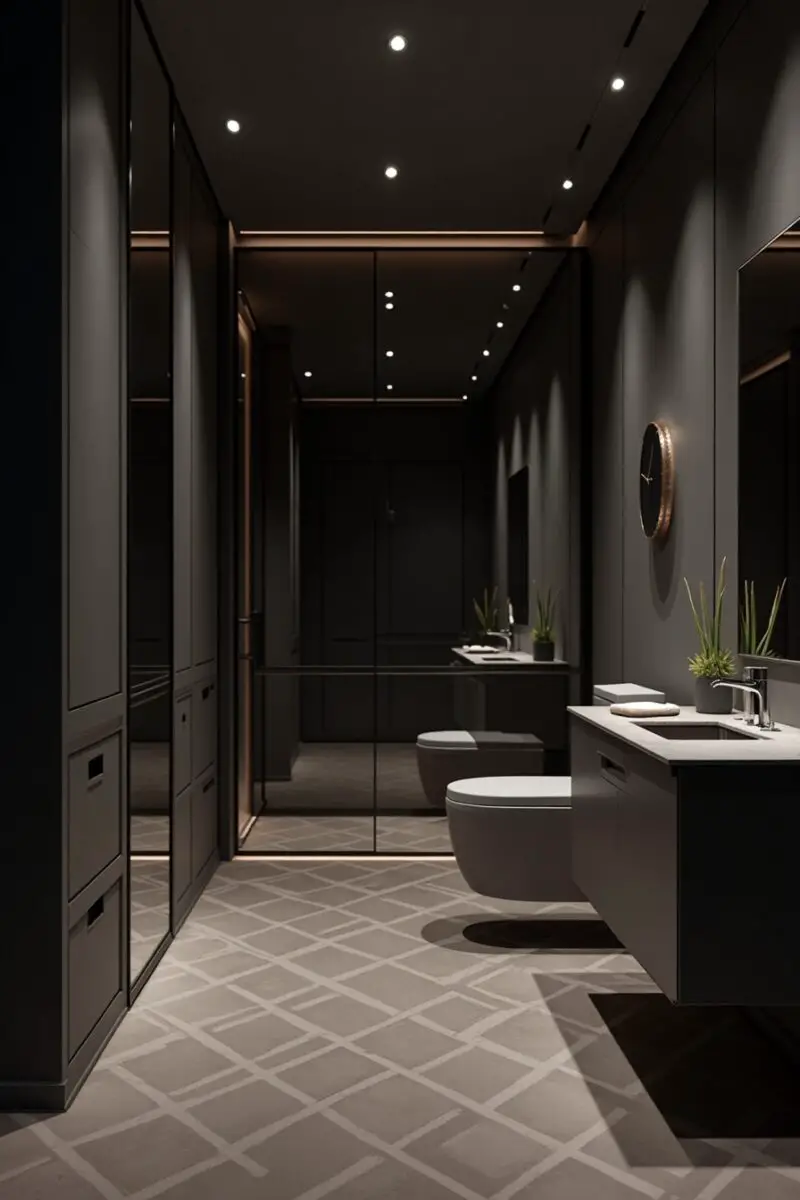
Small dark bathrooms benefit tremendously from visual tricks that manipulate perception and create the feeling of expanded dimensions.
Consider vertical striped wallpaper on a single wall to draw the eye upward and emphasize height rather than width.
Install floor tile on a diagonal to create longer sight lines that make narrow spaces appear wider.
Use the same material on both floors and walls to eliminate visual breaks that can make a space feel chopped up and smaller.
Consider a glass shower panel instead of a curtain to maintain uninterrupted sight lines throughout the entire bathroom.
Large-scale patterns counterintuitively make small spaces feel larger than small busy patterns that can appear cluttered.
Position a large mirror opposite your bathroom’s best feature to visually double the space and create the illusion of a much larger room.
Continue floor tile into the shower without transitions or curbs to create a seamless flow that expands perceived floor space.
Paint ceiling the same color as walls to eliminate the harsh line where they meet, creating a more enveloping space without obvious boundaries.
Remember that in small bathrooms, creating a cohesive look with fewer visual interruptions always makes the space feel larger and more intentional.
Living Elements That Thrive In Low-Light Bathroom Environments

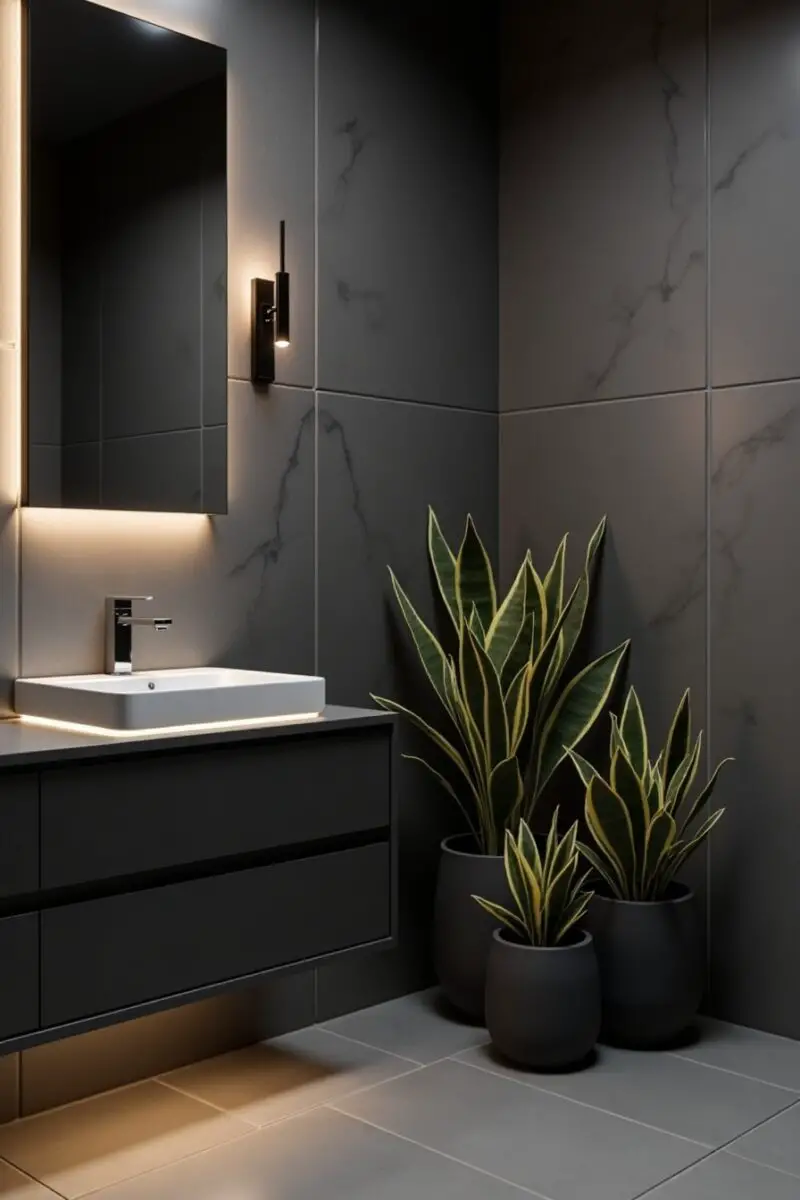
Adding life to a small dark bathroom doesn’t require sacrificing precious counter space or struggling with plants that need bright light.
Consider pothos or snake plants that actually prefer low light conditions and thrive in bathroom humidity.
Install a vertical garden system on one wall for dramatic impact that doesn’t consume valuable floor space.
Look for unusual varieties like black ZZ plants or deep purple tradescantia that complement dark color schemes.
Consider preserved moss panels that require zero maintenance while adding texture and a connection to nature.
Incorporate botanical prints or pressed herbs in dark frames for nature references that don’t require light or care.
Place small air plants in wall-mounted containers to create living sculpture that utilizes vertical space.
Consider a single spectacular orchid with proper care—they can bloom for months in low light, creating a luxurious focal point.
Remember that in dark bathrooms, the contrast between living elements and manufactured materials creates compelling visual tension.
Even artificial plants have come a long way—high-quality faux specimens can add the visual benefit of greenery without the light requirements.

